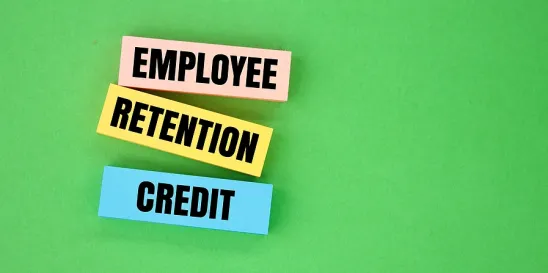On Dec. 21, 2023, the Internal Revenue Service (IRS) announced a new voluntary disclosure program (VDP) for taxpayers who have received an employee retention credit (ERC) refund for which they might not have been eligible. Eligible taxpayers wishing to participate in the VDP must apply by March 22, 2024. This VDP is a civil settlement program separate from the IRS Criminal Division Voluntary Disclosure Practice. Taxpayers accepted into the VDP must pay back 80% of the ERC that was refunded to them. In addition to allowing eligible participants to keep 20% of the claimed ERC refund, the IRS will not require taxpayers to pay interest or penalties on the amount of the ERC repaid to the IRS (provided it is paid when the taxpayer enters into a closing agreement with the IRS), nor to amend income tax returns to reduce any wage expense pursuant to the amount of the ERC refund the taxpayer is allowed to keep. The IRS may be using this VDP to obtain information from taxpayers on the consultants, advisors, preparers, and promoters who helped them file the ERC claims.
To be eligible for the VDP, the following conditions must be satisfied: (1) the taxpayer is not under criminal investigation and has not been notified by the IRS that it intends to commence a criminal investigation; (2) the IRS has not received information from a whistleblower regarding the taxpayer’s noncompliance or received any such information as the result of an enforcement action; (3) the taxpayer is not under an employment tax examination for any quarters for which the ERC was claimed; and (4) the taxpayer has not previously received a demand for repayment of the ERC.
Given these eligibility requirements, taxpayers wishing to participate in the VDP should act swiftly before any of the potentially disqualifying factors arise. The information on the ERC consultants obtained from other persons participating in the VDP or from IRS enforcement actions against ERC consultants could lead the IRS to other clients of the consultant and the initiation of audits of these taxpayers.
If the taxpayer qualifies for the VDP, the taxpayer will be required to repay 80% of the ERC refund but may keep the remaining 20%. This appears to be an acknowledgment by the IRS that many who claimed the ERC paid a fee to their consultant—typically 20%—and might not otherwise be able to recoup this fee from the consultant. In addition, the taxpayer will not have to repay any interest received when the IRS originally paid the ERC. The IRS also will waive all penalties and any interest due on the underpayment of taxes if the taxpayer is able to pay back the ERC when a closing agreement is entered into with the IRS at the end of the VDP process. Taxpayers needing additional time to pay back the ERC refund must seek an installment agreement with the IRS. Penalties and interest may apply if there is an installment agreement.
The ERC rules required a taxpayer who claimed the ERC to file amended income tax returns to reduce the deduction for wages paid by the amount of the ERC to avoid double-dipping (i.e., no income tax deduction for the wages subject to the credit). The VDP provides that if the taxpayer has not filed such amended income tax returns reducing the deduction for wages, they are not required to do so (even for the 20% portion of the credit the taxpayer keeps). Furthermore, if the taxpayer has already filed amended income tax returns to reduce the deduction for wages for which the ERC was claimed, they may file a new amended return to reverse the reduction of the deduction for wages paid.
Finally, the taxpayer must provide the name, address, and phone number of any adviser or consultant who assisted with the ERC claim filing. This is designed to identify consultants who advised their clients to take overly aggressive positions but could also result in inquiries of the taxpayer’s tax return preparer whose client followed the advice of an ERC consulting firm.
The IRS announcement included frequently asked questions (FAQs) concerning the program and its terms and procedures. The IRS also provided a new specialized Form 15434, the Application for Employee Retention Credit (ERC) Voluntary Disclosure Program, to apply for the voluntary disclosure relief. If a taxpayer used a third-party payor to pay wages (such as a professional employer organization), the third-party payor must submit the application under the VDP.
The announcement of the new VDP follows the IRS’s ongoing initiative to combat the filing of erroneous ERC claims and the marketing of those claims by aggressive promoters. The IRS previously announced a moratorium on the processing of all ERC claims until at least the end of the year and a withdrawal initiative that allows ineligible businesses to withdraw their pending ERC claims without incurring any interest or penalties on their claims if the refund was not issued or the refund check was not cashed (see our September 2023 GT Alert). In addition, the IRS is continuing to aggressively investigate ineligible businesses that claimed the ERC both civilly and criminally. With the announcement of the new VDP, the IRS also announced it is sending up to 20,000 letters to businesses with proposed tax adjustments to recapture the erroneously claimed ERC. This follows the notices sent to 20,000 other taxpayers earlier this month notifying them that their ERC claims were being denied.
Given the relatively short window for applying for the VDP and the technicalities associated with eligibility and processing, taxpayers who received ERC refunds to which they may not have been entitled, in whole or in part, should consult with their tax professionals about applying for VDP relief before the program ends or the taxpayer’s eligibility changes.





 />i
/>i

